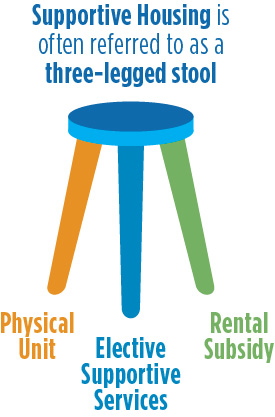Rental Assistance

Developing housing and providing supportive services is often not enough. The majority of people transitioning from institutions cannot access housing because their only source of income, Supplemental Security Income (SSI) or Social Security Disability Insurance (SSDI), is too little for even the most affordable of housing.
Housing only becomes accessible to this population when rental subsidy is provided. Supportive housing is often referred to as a three-legged stool: physical unit, elective supportive services and rental subsidy.
The vast majority of rental assistance programs are administered by public housing authorities. If you are seeking rental assistance for units in your development, the best place to start is with your local housing authority.
If you are applying for 9% LIHTC and you can show that you have secured unit based (rather than tenant based) rental assistance, you may be eligible for additional points toward your application score. Please reference the QAP for more information.
From time to time, IHDA does have rental assistance available for developments. Currently, we are administering the Section 811 Supportive Housing for Persons with Disabilities program (S811) which provides federal funds to subsidize rental housing that offers access to supportive services, assisting states in meeting their obligations under the Supreme Court’s Olmstead decision and making it easier for persons with disabilities to live independently in the community of their choice.
Section 811 – More Details
Funding Source:
The U.S. Department of Housing and Urban Development
Award Amount:
Round 1: $11.982 million
Round 2: $ 6.4 million
Total $18.382 million
Eligible Customers:
Tenants must be extremely low-income (within 30 percent of the median income for the area) with at least one adult member with a disability and be referred through the Statewide Referral Network. Class members of Williams, Colbert and Ligas consent decrees; participants in Money Follows the Person; and, people exiting State Operated Development Centers have been identified as eligible populations as part of the state’s Transforming Healthcare and Human Services (THHS) initiative.
Eligible Housing:
The assistance can be applied to new or existing regulated multifamily housing funded through different IHDA sources, such as Federal Low-Income Housing Tax Credits, Federal HOME funds, and other state, Federal, and local programs.
Program Implementation:
IHDA awards the rental subsidy to owners of eligible properties via a selection process. Each rental subsidy awarded will have an initial term of five years with renewals for up to 20 years. The units will be filled through the existing State Referral Network that links service providers with housing through the Statewide Housing and Employment First Coordinator in the Office of the Governor and five regional Lead Referral Agencies.
Geographic Distribution:
Statewide; with emphasis placed on units in areas of high need to support the State’s rebalancing efforts.

